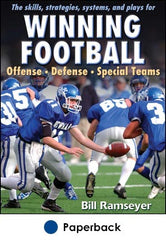Defensive football drills: Intercepting the ball
This is an excerpt from Winning Football by Bill Ramseyer.
Whether playing man or zone, defenders must play the man until the ball is in the air, and then play the ball. Until the ball is thrown, the receiver can hurt the defender. Once the ball is released, the receiver can no longer hurt the defender; only the ball can do that.
The mechanics of catching the ball are the same regardless of which side the catcher is on, whether he's on offense or defense. The receiver catches the ball with his fingertips, where there are more nerve endings, not with the flesh of his hands. One difference in catching on offense and intercepting on defense, which should be reflected in interception drills, is that often the defender is moving toward the line of scrimmage. The defender must attack the ball and catch it at the highest point possible. Interception drills should stress playing through the receiver to the ball, catching the ball at a high point, increasing the distance that the defender can cover while the ball is in the air, and being physical, ensuring that if the defender can't catch the ball, the receiver can't either.
Jump Ball
Stand side by side against a receiver. A coach throws the ball up as a basketball referee would for a tipoff. Practice jumping as high as possible, timing the jump so you contact the ball at the maximum height of your jump. Control the ball and come down with it.
Hail Mary
Working against receivers, sprint 40 yards into the end zone and time your jump to come down with the ball to win the game. Practice reacting to a tipped ball, which is usually what happens with a Hail Mary in a game.
Interception Challenge Drill
Two players stand 15 yards in front of a coach and 7 yards apart. The coach throws the ball between them, and both players go after it. Players must play the ball, and the best man comes down with it. Players try to intercept the ball at its highest point.
Covering the Hooks
Two receivers stand 12 yards deep and 7 yards apart. The linebacker is in his normal starting position. He quickly drops between the two receivers as the quarterback begins his drop. Without faking, the passer throws to one of the receivers. The linebacker makes the interception and returns it at full speed. If you have enough quarterbacks, use the scout team quarterback for this drill.
Come to Drill
The defensive backs line up 20 yards in front of the coach. At the signal, the first back starts forward at full speed. The coach passes the ball to him. The defender catches the ball and sprints to the coach. The coach throws the ball high most of the time so the defender must judge the height of the ball. Sometimes the coach throws the ball slightly to the right or left of the defensive back.
Goal Post Drill
This drill increases the interception distance of the defensive backs. Two defenders stand under the goal post. A receiver stands in each corner of the end zone. The quarterback takes a five-step drop, stops, and throws to one corner. The defensive backs sprint for the corner as soon as the quarterback moves. They must get to the corner in time to intercept the ball. If you have enough quarterbacks, use the scout team quarterback for this drill.
Long-Ball Drill
As the quarterback retreats to throw, the defensive back moves laterally to cover the out route. The quarterback sets up and either throws to the defensive back in the flat or makes the motion, pats the ball, and brings it back to throw the long one. When the quarterback pats the ball, the defensive back turns upfield and races for the interception. If you have enough quarterbacks, use the scout team quarterback for this drill.
Play the Ball Drill
Place two cones 15 yards apart where the defensive back lines up, and two more cones at a point 20 yards downfield. Receivers station just inside the two cones at the line of scrimmage. The defensive back stations midway between the other two cones. When the quarterback starts the play, the receivers sprint downfield just inside the cones, and the defensive back backpedals. When the quarterback throws to one of the two downfield cones, the defensive back reacts and intercepts the ball. Start with the cones 15 yards apart; as the defensive back gains confidence, widen the distance to 20 yards. If you have enough quarterbacks, use the scout team quarterback for this drill.
Learn more about Winning Football.
More Excerpts From Winning Football

Get the latest insights with regular newsletters, plus periodic product information and special insider offers.
JOIN NOW


